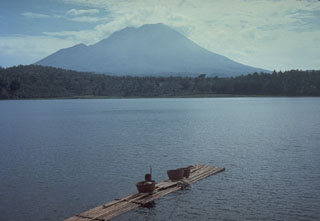Report on Lamongan (Indonesia) — October 1985
Scientific Event Alert Network Bulletin, vol. 10, no. 10 (October 1985)
Managing Editor: Lindsay McClelland.
Lamongan (Indonesia) Seismic swarm near site of 1924-25 and 1978 swarms
Please cite this report as:
Global Volcanism Program, 1985. Report on Lamongan (Indonesia) (McClelland, L., ed.). Scientific Event Alert Network Bulletin, 10:10. Smithsonian Institution. https://doi.org/10.5479/si.GVP.SEAN198510-263320
Lamongan
Indonesia
7.981°S, 113.341°E; summit elev. 1641 m
All times are local (unless otherwise noted)
"Lamongan experienced a seismic swarm with ground breakage 2-15 October. More than 3,000 earthquakes were recorded at the VSI observation post at Gunungmeja, near Klakah, W of Lamongan (figure 1). Two additional seismometers were installed in the epicentral area on 5-6 October. Ground breakage occurred in a region ~5 km W of the summit and consisting of numerous ground cracks, some with vertical offsets of 15 cm, striking ENE. No changes were noted in the temperatures or character of the many lakes in the Lamongan area, which fill maars created by prehistoric eruptions. The 1985 activity is in the same general area as two seismic swarms that occurred in 1924-25 and in 1978 but did not culminate in eruptions."
"Lamongan was quite active during the 19th century with 40 eruptions, including more than a dozen that produced lava flows. Most were from vents located on the W flank above about 400 m altitude. It is notable that the maars on the W slope of Lamongan all occur at elevations below the historic eruption vents, suggesting that the position of the groundwater table controls its eruptive style. Eruptions from above 400 m altitude form fissure vents and cinder cones that pose little threat to the local inhabitants. Activity from vents below 400 m may give rise to explosive, maar-forming eruptions. The 1985 epicentral area has a surface elevation of 200-380 m. Plans are underway to increase the level of surveillance."
Reference. Van Bemmelen, R., 1949, The geology of Indonesia, v. 1B: M. Nijhoff, The Hague.
Geological Summary. Lamongan, a small stratovolcano located between the massive Tengger and Iyang-Argapura volcanic complexes, is surrounded by numerous maars and cinder cones. The currently active cone has been constructed 650 m SW of Gunung Tarub, the volcano's high point. As many as 27 maars with diameters from 150 to 700 m, some containing crater lakes, surround the volcano, along with about 60 cinder cones and spatter cones. Lake-filled maars, including Ranu Pakis, Ranu Klakah, and Ranu Bedali, are located on the E and W flanks; dry maars are predominately located on the N flanks. None of the maars has erupted during historical time, although several of the youthful maars cut drainage channels from Gunung Tarub. The volcano was very active from the time of its first historical eruption in 1799 through the end of the 19th century, producing frequent explosive eruptions and lava flows from vents on the western side ranging from the summit to about 450 m elevation.
Information Contacts: J. Matahelumual, Suparto S., and T. Casadevall, VSI.


